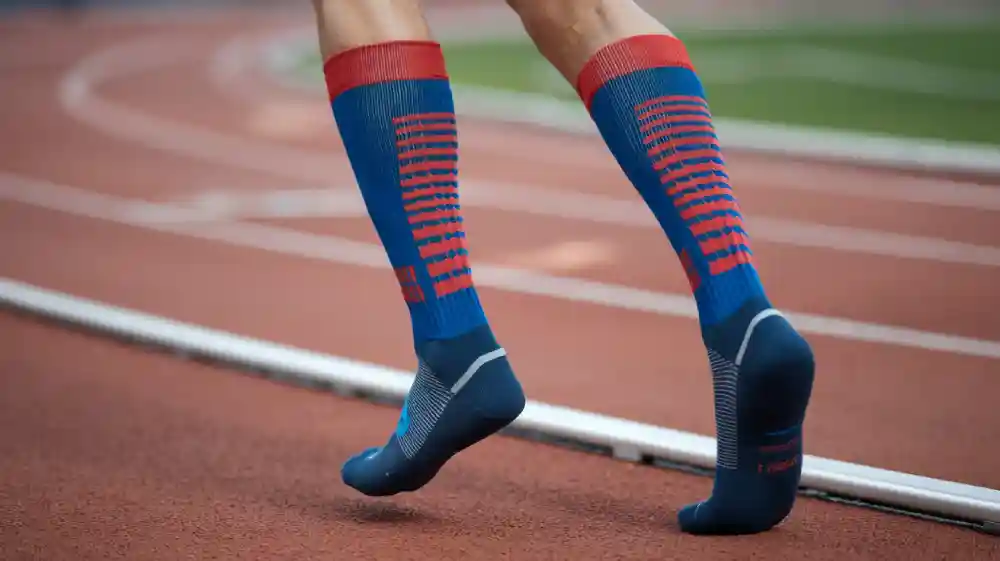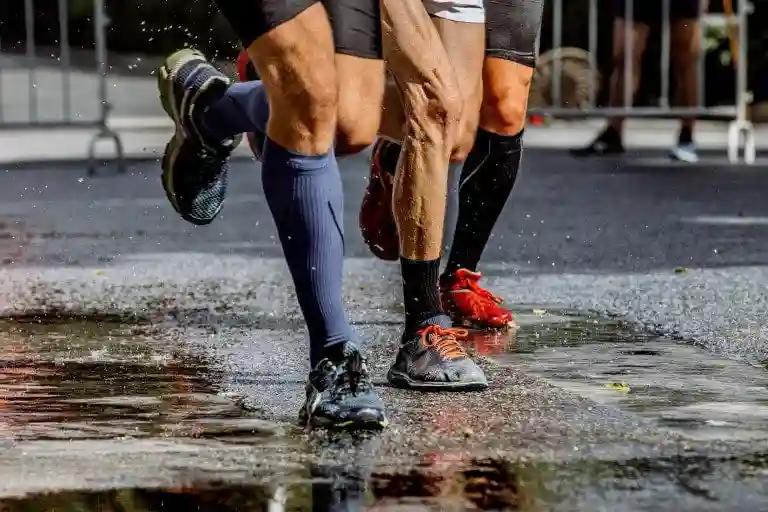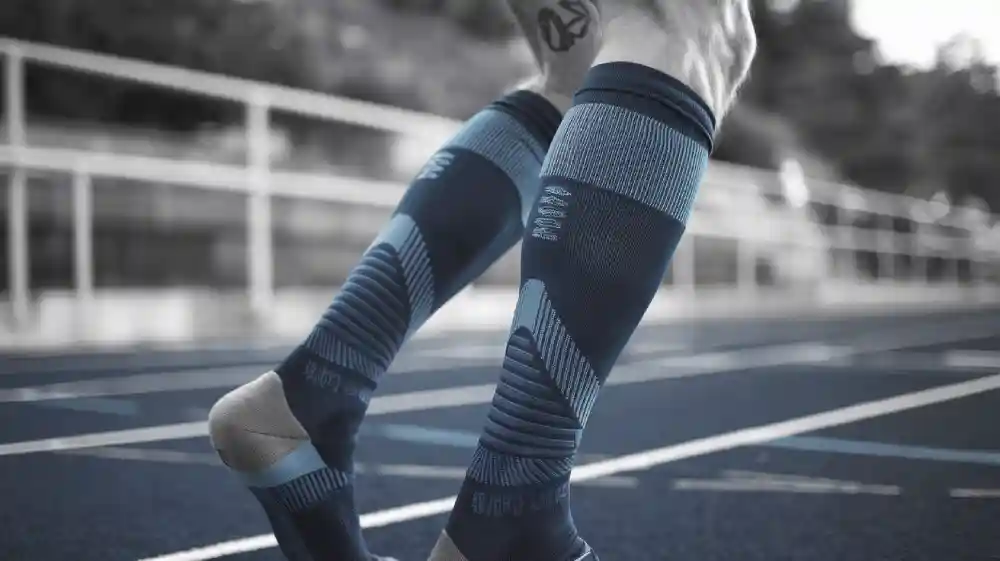
Compression socks are no longer just a niche product for athletes. With the rise of wellness-focused consumers and an increasing emphasis on recovery and performance, these socks have become a key offering for brands catering to active lifestyles. Retailers and manufacturers who ignore this trend risk missing a valuable opportunity to enhance their product range and meet growing customer expectations. Offering compression socks positions your brand as a leader in the expanding market for health and recovery solutions—now is the perfect time to get involved.
What Are Running Compression Socks?
Running compression socks are specially designed garments made from elastic materials that apply controlled pressure to the legs and feet. Their functionality relies on a graduated compression design: tighter around the ankle and gradually loosening up the leg. This design enhances blood flow, improving circulation during activity and promoting faster recovery post-exercise. Crafted from durable fabrics like nylon and spandex, these socks offer both support and comfort during intense physical activity.
Key Running Compression Socks Benefits for Consumers
Enhanced Circulation and Muscle Recovery
Running compression socks are designed to promote better circulation by applying graduated pressure, which helps blood flow back to the heart more efficiently. This improved circulation ensures muscles receive the oxygen and nutrients they need during physical activity while removing metabolic waste like lactic acid. This reduces muscle fatigue and quicker recovery times for consumers, allowing for a faster return to training and better overall performance.
Injury Prevention and Reduced Swelling
One of the most important benefits is injury prevention. These socks help stabilize the muscles and joints by providing targeted support, reducing the risk of strains and sprains. This is particularly beneficial for long-distance runners or those who engage in high-impact activities. Compression socks also help to control swelling by encouraging the return of blood and fluids back toward the heart, preventing fluid accumulation in the lower legs. For many, this reduces discomfort and speeds up post-activity recovery.
Comfort and Stability During Long Runs
Compression socks’ snug, supportive fit enhances comfort during extended physical activity. The pressure they provide helps to reduce muscle vibration, which can lead to fatigue and discomfort during long runs. Runners often experience improved stability and reduced muscle soreness, allowing them to perform better and feel more comfortable throughout their workout. The socks provide a sense of security, keeping muscles aligned and reducing the chances of cramping or muscle tightness during prolonged runs.
Effects on Different Groups of People
- Benefits for Athletes: Performance Enhancement and Recovery
While the evidence on compression socks’ ability to enhance athletic performance is mixed, there’s strong support for their recovery benefits. Studies have shown that wearing compression gear doesn’t significantly affect muscle oxygenation during activity, and its impact on muscle damage markers is minimal. However, in certain scenarios, athletes may notice improved running efficiency and endurance. More notably, compression socks have been shown to aid in faster recovery by reducing muscle soreness and fatigue after intense workouts. By improving blood flow and speeding up the removal of lactic acid, they help athletes recover more quickly and get back to training sooner. Whether it’s for alleviating soreness post-race or boosting comfort during long training sessions, compression socks are an essential recovery tool for athletes.
- Benefits for the General Population: Wellness and Everyday Comfort
Compression socks provide a wide range of benefits for individuals who may not be actively involved in sports but still experience circulatory issues or long periods of physical strain. For those dealing with conditions like varicose veins, deep vein thrombosis, or diabetes, compression wear improves blood flow, reduces swelling, and helps alleviate pain. Additionally, for people who stand or sit for extended hours, such as office workers or retail employees, these socks offer much-needed relief by preventing blood from pooling in the legs, reducing fatigue, and minimizing discomfort. They also play a vital role in post-surgical recovery, promoting circulation and lowering the risk of complications like blood clots. Whether someone is recovering from surgery or simply enduring a long day on their feet, these socks can enhance comfort and promote better circulation.

Running Compression Socks Benefits for Brands: More Than Just a Trend
Meeting Consumer Demands
In today’s market, consumers are increasingly prioritizing wellness and performance. As more individuals become aware of the long-term benefits of active recovery and muscle support, the demand for compression socks has risen significantly. These socks aren’t just for athletes anymore—they appeal to anyone seeking better circulation, reduced fatigue, and faster recovery, from office workers to travelers. With a growing focus on health-conscious lifestyles, running compression socks have become a core product for meeting these consumer expectations. For brands, failing to offer such products could mean missing a key opportunity to stay relevant to a wide-ranging, performance-driven audience.
Differentiating Your Brand
The market for active lifestyle and wellness products is saturated, making differentiation critical. Offering running compression socks can help your brand carve out a unique space by addressing consumer needs in a meaningful way. These products provide more than just aesthetic value—they’re functional, providing real benefits like improved circulation and muscle recovery. By offering compression socks, brands can elevate their reputation as a solution provider, not just a seller of goods. You can go beyond typical offerings by incorporating innovative features—whether it’s advanced fabric technology, tailored compression levels, or custom designs—that speak directly to the consumer’s needs. By taking a unique approach to compression socks, brands can distinguish themselves in a crowded marketplace and build strong consumer trust.
The Growing Market
The surge in interest for wellness products is not a temporary trend, but a shift toward sustainable, health-driven consumer behavior. As more individuals prioritize their fitness and recovery, the demand for products like compression socks continues to rise. This expanding market isn’t limited to professional athletes; everyday consumers now recognize the advantages of such products for reducing muscle strain and improving circulation, regardless of whether they’re exercising or just enduring long hours of sitting or standing. For brands, this opens up the opportunity to offer products that serve a broad spectrum of customers—athletes, health-conscious individuals, and those simply looking for comfort. The increasing focus on personal well-being presents a growing market that brands can tap into by offering products that align with this lifestyle shift.
How Offering Compression Socks Can Expand Your Product Line
Incorporating running compression socks into your product line isn’t just about adding another item to your inventory; it’s about expanding your brand’s relevance in the wellness and active recovery space. Compression socks provide an opportunity to diversify your offerings by addressing both functional and aesthetic needs. They can easily complement other fitness or lifestyle products, creating a natural fit within existing categories like athletic wear, recovery tools, or medical apparel. By adding compression socks, your brand is demonstrating its ability to meet a broader range of consumer needs, from athletic performance to general wellness. Additionally, offering a well-crafted, high-quality product increases the chances of attracting repeat customers who value performance-driven solutions.
Understanding Pricing and Margins
The market for compression socks offers brands significant profit potential, particularly if they understand the pricing dynamics. Compression socks are often seen as a premium product, with consumers willing to pay a higher price for added benefits like muscle recovery, injury prevention, and comfort. The key to profitability lies in balancing the manufacturing cost with the perceived value of the product. While the cost of materials and production may be higher for quality compression socks, the demand allows brands to price them at a premium while maintaining a strong margin. By offering different variations—such as economy, mid-range, and premium options—brands can cater to various price points without compromising quality, ensuring there’s an offering for every consumer segment.
Building Brand Loyalty
Offering high-quality running compression socks can foster deep customer loyalty, which is crucial for long-term business growth. Customers who experience the benefits of compression—reduced fatigue, improved recovery, and enhanced comfort—are more likely to return for future purchases. Moreover, by delivering a consistently reliable product, brands can earn the trust and confidence of their customers. Loyalty is not just about repeat sales; it’s also about word-of-mouth marketing. Satisfied customers are likely to recommend your product to friends, family, and online communities, effectively expanding your brand’s reach. The value of customer loyalty is immense, especially in a competitive market, where word-of-mouth endorsements and positive reviews drive future success. By offering a product that delivers real results, brands can build a solid foundation for sustained growth and a loyal customer base.

Purchase and Use Suggestions: How to Choose the Right Compression Socks
When advising customers, it’s important to align the compression level with their specific needs. For those interested in general wellness or sports, moderate compression (15-20 mmHg) is typically sufficient to support circulation and prevent fatigue. At the same time, compression socks must be neither too tight nor too loose. A professional fitting or measuring the calf circumference ensures the right balance, allowing for maximum benefits without discomfort. Additionally, remind customers that compression socks should be worn during the day for active use and should not be worn overnight. By guiding customers through these considerations, you can help them find the best pair to suit their needs and ensure maximum comfort and effectiveness.
How to Choose the Right Supplier for Custom Compression Socks
- Key Factors to Consider When Partnering with a Manufacturer
When selecting a supplier for custom compression socks, the first consideration should be their ability to meet your specific needs, whether it’s for unique designs, bulk orders, or delivery timelines. Evaluate their track record in the industry, including their experience with custom products, reliability in meeting deadlines, and capacity for handling large orders. Additionally, transparency in communication is essential. A good manufacturer should be responsive, open to collaboration, and able to provide detailed production timelines and clear pricing structures.
- Customization Options: From Design to Material Selection
A key advantage of working with the right supplier is the flexibility in customization. Look for manufacturers who offer a range of options, from fabric choices to design details like color, patterns, and logos. We also produce more special function compression socks, such as anti-slip compression socks, anti-odor compression socks, essential oil compression socks, graphene compression socks, copper compression socks, etc. Customization should also extend to packaging options to ensure the finished product fits your brand image and matches different sales channels (Amazon, retail, supermarkets, etc.).
- Why Reliability and Quality Control Matter for Your Brand
Reliability and quality control are paramount when partnering with a manufacturer. Look for a supplier with a proven quality assurance process that includes material testing, production checks, and final product inspections. To guarantee the highest standards, we adopt AQL (Acceptable Quality Level) standards for inspections, ensuring that every pair of compression socks meets rigorous criteria.
Our team inspects each pair of socks to ensure consistency in both appearance and functionality. We also maintain a dedicated area for defective socks, where examples are clearly marked and displayed. This helps workers identify quality issues and learn from past mistakes, creating a continuous improvement loop. This ongoing training ensures that our products consistently meet the highest quality standards, reinforcing our commitment to excellence.
Conclusion: Taking Advantage of Running Compression Socks Benefits
Running compression socks are no longer just a trend—they’re a must-have for brands looking to meet growing consumer demand for wellness and performance products. With the right supplier, you can customize socks to align with your brand while ensuring reliability, quality, and on-time delivery.
Ready to elevate your product line? Contact us today to partner on custom compression socks that deliver value to your customers and set your brand apart.
FAQs
Can custom compression socks be designed with unique features or materials?
Absolutely! Custom compression socks can be designed with various features, such as moisture-wicking fabrics, anti-odor treatments, or specialized materials like copper-infused yarn or graphene. These unique features add value to your product line, making your socks stand out in the market and catering to specific customer preferences.
How do I determine the right compression level for my product line?
The ideal compression level depends on your target market. For general wellness and athletic use, socks with a compression range of 15-20 mmHg are common. For medical or therapeutic use, higher compression (20-30 mmHg) may be necessary. It’s important to align compression levels with your customers’ needs, whether they’re seeking performance, recovery, or health benefits.
Can I offer compression socks with different designs or patterns to attract more customers?
Definitely! Custom compression socks can be designed with various colors, patterns, and even personalized logos to match your brand’s style. Unique designs can make your socks more attractive to consumers, especially those looking for functional fashion. Adding creative elements can appeal to specific target groups, such as athletes, fitness enthusiasts, or fashion-conscious customers.
Can custom compression socks be produced in eco-friendly materials?
Yes, custom compression socks can be produced with eco-friendly materials. As a manufacturer committed to sustainability, we use yarns that are STANDARD 100 certified by OEKO-TEX, ensuring that the raw materials are free from harmful substances and safe for all consumers, including babies. We also prioritize sustainability by selecting recycled polyester and natural eco-friendly fibers for our compression socks, which are not only environmentally friendly but also durable and functional. To minimize our environmental impact further, we use recyclable and biodegradable materials for packaging. This approach allows us to deliver high-quality, eco-conscious products that align with the growing consumer demand for sustainable options.
Are there any health or safety concerns with wearing compression socks?
Compression socks are generally safe for most people, but there are a few exceptions. Individuals with conditions like severe peripheral arterial disease, skin infections, or heart problems should consult a healthcare professional before using them. It’s important to educate your customers on proper use, including not wearing them too tight or overnight, to ensure both comfort and safety.
